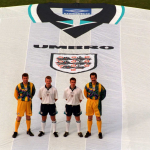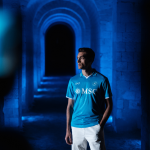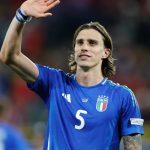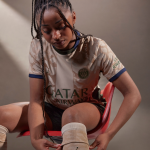
The Evolution of the Football Kit Launch - From early '80s to the new millennium
Over the years, the presentations have gradually refined, defining the changes that football itself has undergone
August 9th, 2022
The growth of football shirts in popular culture and fashion has been an ongoing phenomenon for a few years now. The technology used in the fabrics evolves and the visual designs change from year to year, with new co-collaborators and designers adding to the hype around new releases, but one aspect of shirt culture has undergone possibly a more drastic change than any other: the kit launch itself.
Kit launches today are a different animal to those of early days in the 80s, when there were two basic types. For the first and most common, a few players, or sometimes the whole squad, would be assembled for a run of the mill photoshoot to show off the new strips. Players stood as if they were posing for their school yearbook, decked out in their team’s latest jersey, shorts and socks. Either the club’s stadium or training ground was the backdrop. These were football players, the product was a football shirt, made to wear while playing football or attending a football match.
In the pre-digital era, the photo opportunity provided by the release of a new jersey was something that shirt sponsors capitalised on too. Occasionally, the sponsor took centre stage as the players peddled goods on their behalf. Having their logo on the front of Manchester United’s 82-83 shirts didn’t suffice for Sharp Electronics, so a couple of VHS players were balanced on the knees of the players for good measure.
The target audience for kits at the time was mainly children, so it made sense that the second basic type of launch featured kids wearing the new shirts rather than the players themselves. Hummel and Umbro both used this technique in campaigns in the late 80s and early 90s, modelling their entire range of Premier League club kits. The young generation were very much in mind when Newcastle United planned the release of their 96-97 home and away strips. They went for the classic team photo with all players present, plus special guests Ant and Dec, two local lads who were the stars of hit kids’ tv show Biker Grove.
From the 80s through to the mid 90s, the poses and settings remained fairly constant and everybody was all smiles in front of the camera, with light-heartedness and simplicity at the core of the whole endeavour. A favourite among Serie A teams was a training ground photoshoot of players donning the latest gear, grinning with a football in their hands, or sometimes placed between their tilted heads, just in case we forgot what purpose the kits served or what these men did for a living.
Although there were still a lot of copy and paste offerings, things started to move forward slightly and a little more variety appeared. The portrayal of fun was key, with an element of novelty also creeping in as a way to grab more attention and get chins wagging. Umbro produced a giant version of England’s Euro 1996 shirt for its unveiling, for example, accompanied by kitted out players who were photographed from above to show off the scale of the operation, a trick repeated by Glasgow Rangers that same year. Liverpool launched their 1996 away kit with four of their players wearing Beatles wigs as they posed with instruments. The following year, hundreds of fans sporting curly wigs and moustaches were photographed in the stadium, grinning and sporting a yellow away jersey.
Many clubs would be red-faced looking back now at the manner in which women were included in their launches. Not all, but most of the time, they were heavily outnumbered by the male participants and given the role of “eye candy”, with Sheffield Wednesday’s 97-98 effort and Celtic’s 92-93 kit launch just a couple of examples. At the time, it was probably all considered part of the fun, but it's no wonder that this particular portrayal is now a thing of the past.
Towards the end of the 90s, the live launch event was gaining popularity as a way to increase exposure, with media outlets invited to the part press conference, part fashion show unveilings that featured players, managers and quite often female models. The catwalk was no longer the reserve of haute couture, it was now employed by football clubs - like Man City for their 97-98 kits - to allow players and models to strut their stuff. On less glamorous occasions, the kits were unveiled the same way new signings were presented to the press - in the conference room against a backdrop of sponsor logos, as both Inter and Milan did around the turn of the century. Print media was still king at the time and photographers’ snapshots from these live events would appear in newspapers and magazines.
The dawn of the 2000s seemed like the beginning of a new technological age, and as more of us began to consume our media online, clubs and manufacturers started to move their focus to their online presence. Before the days of social media dominance, club websites were the place to go when you wanted to check out your team’s new top. Despite this new medium coming to the fore, the aesthetic of the launches themselves remained quite stable throughout the early to late 2000s. Press room backdrops, stadium shoots and standard camera angles reigned supreme.
One very noticeable change in and around this period, however, was the disappearance of the previously omnipresent smile. Slowly but surely, the cheerful expressions that had been a trademark of these marketing campaigns began to be phased out. Perhaps involuntarily in the beginning, as the players' facial muscles were bound to get tired after hours of looking happy for the cameras at live events, but it was definitely the beginning of a more intentional shift that would happen in the years to come.
When comparing the pictures from the 80s with those from the 2000s, developments are clearly visible - the quality of the photos, the style and fit of the shirts and some of the poses adopted - but a lot of similarities remained. In line with the exponentially accelerating speed at which technology has been advancing over the last 10-15 years, the greatest changes in how shirts are marketed have come in that same period. Part two of this article will delve into how we have arrived at the current peak, aided by the aggressive marketing techniques made possible by social media.


































